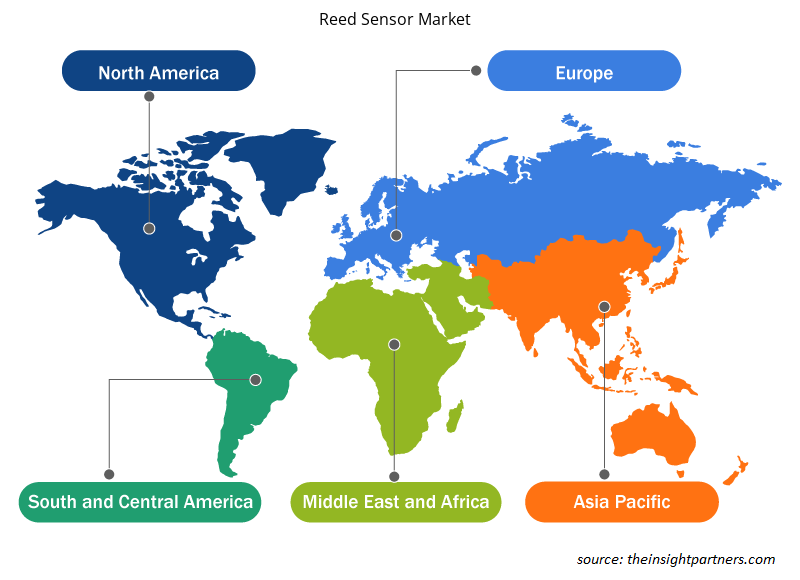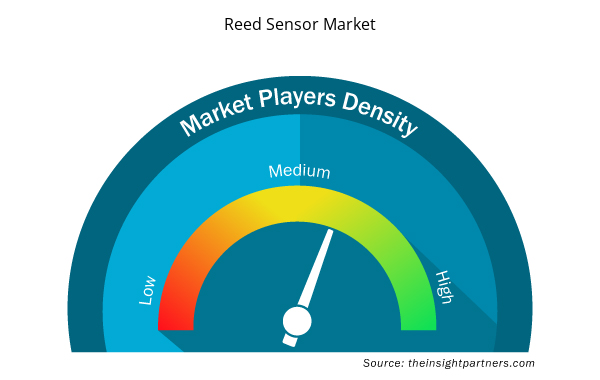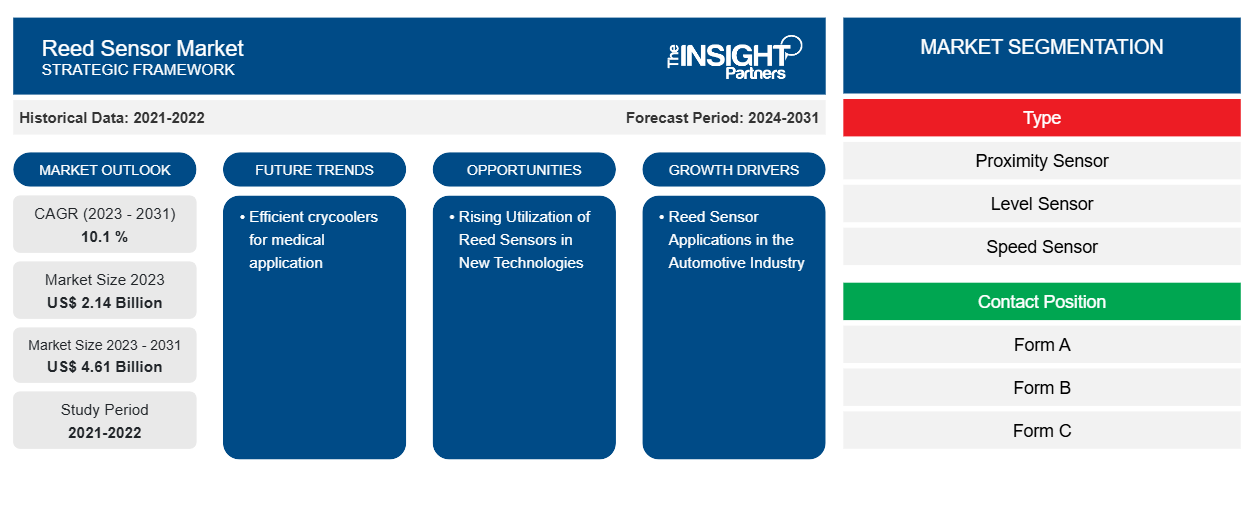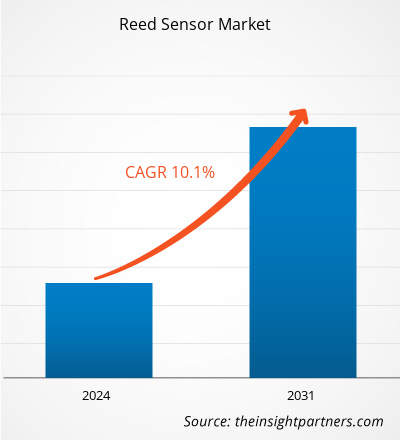Der Markt für Reed-Sensoren soll von 2,14 Milliarden US-Dollar im Jahr 2023 auf 4,61 Milliarden US-Dollar im Jahr 2031 anwachsen. Der Markt soll zwischen 2023 und 2031 eine durchschnittliche jährliche Wachstumsrate (CAGR) von 10,1 % verzeichnen. Die Nachfrage steigt aufgrund einer Vielzahl von Variablen, die technische Entwicklungen in einer Vielzahl von Branchen vorantreiben, rasant an.
Reed-Sensor-Marktanalyse
Reed-Sensoren werden in der Fahrzeugindustrie, insbesondere im Fahrzeuginnenraum, häufig eingesetzt, da sie zuverlässige und einfache Erkennungs- und Betätigungsfunktionen bieten, kostengünstig sind und für den Betrieb keinen Strom benötigen. Daher wird erwartet, dass die Expansion der Automobilindustrie den Einsatz von Reed-Sensoren in Zukunft vorantreiben wird. Allerdings wird erwartet, dass die Nachfrage nach Reed-Sensoren aus der Robotik und Automatisierungstechnik mit der Zeit steigen wird.
Marktübersicht zu Reed-Sensoren
Reed-Sensoren bieten verschiedene Vorteile, darunter einfache und zuverlässige Sensor- und Betätigungsfunktionen, niedrige Kosten und minimalen Strombedarf sowie Sicherheit in rauen Industrieumgebungen. Diese Faktoren tragen zur Marktexpansion bei. Mit der Entwicklung neuer Anwendungen und Technologien gewinnt der Markt an Zugkraft. Sensoren werden in einer Vielzahl von Anwendungen eingesetzt, darunter Telekommunikation, Automobil und Transport, Unterhaltungselektronik und -geräte, Sicherheit und Schutz, Gesundheitswesen, Bauwesen, Robotik und Automatisierung.
Passen Sie diesen Bericht Ihren Anforderungen an
Sie erhalten kostenlose Anpassungen an jedem Bericht, einschließlich Teilen dieses Berichts oder einer Analyse auf Länderebene, eines Excel-Datenpakets sowie tolle Angebote und Rabatte für Start-ups und Universitäten.
- Holen Sie sich die wichtigsten Markttrends aus diesem Bericht.Dieses KOSTENLOSE Beispiel umfasst eine Datenanalyse von Markttrends bis hin zu Schätzungen und Prognosen.
Treiber und Chancen auf dem Reed-Sensor-Markt
Reed-Sensor-Anwendungen in der Automobilindustrie begünstigen den Markt
Ein Auto enthält eine Reihe von Sensoren, die den ordnungsgemäßen Betrieb seiner zahlreichen Komponenten gewährleisten. Reed-Sensoren werden häufig in Fahrzeuginnenräumen verwendet, um Sicherheit und Zuverlässigkeit zu gewährleisten. Reed-Sensoren sind aufgrund ihres geringen Stromverbrauchs und ihrer langen Lebensdauer perfekt für Automobilanwendungen geeignet. Reed-Sensoren werden in einer Vielzahl von Automobilanwendungen eingesetzt, darunter Sonnenblenden, Frühbremssensoren, Abgassensoren, elektrische Fensterheber, Tankdeckelpositionssensoren, Antiblockiersysteme, Kühlmittelflusssensoren, defekte Lampenerkennung, Überwachung niedriger Flüssigkeitsstände, Batterielebensdaueranzeigen, Sicherheitsgurtverriegelungssensoren, Airbag-Auslöseschutz, Türsensoren, Tempomat und Servolenkung. Das Wachstum der Automobilindustrie treibt den Markt für Reed-Sensoren an.
Zunehmender Einsatz von Reed-Sensoren in neuen Technologien
Der zunehmende Einsatz von Reed-Sensoren in neuen Technologien wird neue Marktchancen schaffen und das Wachstumstempo des Marktes beschleunigen. Der Trend zu hoher Miniaturisierung und außergewöhnlich zuverlässigen Reed-Schaltern wirkt als Treiber für den Reed-Sensor in einer Vielzahl von Endverbraucherbranchen, was auf technologische Fortschritte in der Sensor- und Schaltertechnologie zurückzuführen ist . Darüber hinaus würden günstige Regierungsinitiativen zur Förderung der Produktion von Unterhaltungselektronik in Entwicklungsländern und neuen Schwellenmärkten als Markttreiber wirken und das Wachstumstempo der Branche steigern.
Segmentierungsanalyse des Reed-Sensor-Marktberichts
Wichtige Segmente, die zur Ableitung der Reedsensor-Marktanalyse beigetragen haben, sind Typ, Kontaktposition und Anwendung.
- Basierend auf dem Typ ist der Markt für Reed-Sensoren in Näherungssensoren, Füllstandssensoren, Geschwindigkeitssensoren und Durchflusssensoren unterteilt.
- Basierend auf der Kontaktposition ist der Markt für Reedsensoren in Form A, Form B, Form C, Form D und andere segmentiert.
- Nach Anwendung ist der Markt in die Bereiche Automobil und Transport, Sicherheit und Schutz, Medizin, Unterhaltungselektronik, Telekommunikation und Sonstige segmentiert.
Reed-Sensor-Marktanteilsanalyse nach Geografie
Der geografische Umfang des Marktberichts für Reed-Sensoren ist hauptsächlich in fünf Regionen unterteilt: Nordamerika, Asien-Pazifik, Europa, Naher Osten und Afrika sowie Südamerika/Süd- und Mittelamerika. Der Asien-Pazifik-Raum wird den etablierten Elektronik- und Automobilsektoren in Taiwan bzw. China zugeschrieben. Shanghai und Peking sind Chinas wichtigste Industriezentren für Autos, Kommunikationsgeräte und Elektronik, was die Marktexpansion für Reed-Sensoren vorantreibt. In Südkorea trägt das Wachstum von Smart-Home-Geräten zum Wachstum des Reed-Sensor-Marktes bei.
Regionale Einblicke in den Reed-Sensor-Markt
Die regionalen Trends und Faktoren, die den Reed-Sensor-Markt während des Prognosezeitraums beeinflussen, wurden von den Analysten von Insight Partners ausführlich erläutert. In diesem Abschnitt werden auch die Marktsegmente und die Geografie des Reed-Sensor-Marktes in Nordamerika, Europa, im asiatisch-pazifischen Raum, im Nahen Osten und Afrika sowie in Süd- und Mittelamerika erörtert.

- Erhalten Sie regionalspezifische Daten zum Reed-Sensor-Markt
Umfang des Marktberichts zu Reed-Sensoren
| Berichtsattribut | Details |
|---|---|
| Marktgröße im Jahr 2023 | 2,14 Milliarden US-Dollar |
| Marktgröße bis 2031 | 4,61 Milliarden US-Dollar |
| Globale CAGR (2023 - 2031) | 10,1 % |
| Historische Daten | 2021-2022 |
| Prognosezeitraum | 2024–2031 |
| Abgedeckte Segmente | Nach Typ
|
| Abgedeckte Regionen und Länder | Nordamerika
|
| Marktführer und wichtige Unternehmensprofile |
|
Dichte der Marktteilnehmer für Reed-Sensoren: Deren Auswirkungen auf die Geschäftsdynamik
Der Markt für Reed-Sensoren wächst rasant. Dies wird durch die steigende Nachfrage der Endnutzer aufgrund von Faktoren wie sich entwickelnden Verbraucherpräferenzen, technologischen Fortschritten und einem größeren Bewusstsein für die Vorteile des Produkts vorangetrieben. Mit der steigenden Nachfrage erweitern Unternehmen ihr Angebot, entwickeln Innovationen, um die Bedürfnisse der Verbraucher zu erfüllen, und nutzen neue Trends, was das Marktwachstum weiter ankurbelt.
Die Marktteilnehmerdichte bezieht sich auf die Verteilung von Firmen oder Unternehmen, die in einem bestimmten Markt oder einer bestimmten Branche tätig sind. Sie gibt an, wie viele Wettbewerber (Marktteilnehmer) in einem bestimmten Marktraum im Verhältnis zu seiner Größe oder seinem gesamten Marktwert präsent sind.
Die wichtigsten auf dem Reed-Sensor-Markt tätigen Unternehmen sind:
- HSI-Sensorik
- Coto-Technologie
- Littelfuse Inc.
- PIC GmbH
- Pickering Electronics Ltd.
- RMCIP
Haftungsausschluss : Die oben aufgeführten Unternehmen sind nicht in einer bestimmten Reihenfolge aufgeführt.

- Überblick über die wichtigsten Akteure auf dem Reed-Sensor-Markt
Neuigkeiten und aktuelle Entwicklungen zum Reed-Sensor-Markt
Der Markt für Reed-Sensoren wird durch die Erhebung qualitativer und quantitativer Daten nach Primär- und Sekundärforschung bewertet, die wichtige Unternehmensveröffentlichungen, Verbandsdaten und Datenbanken umfasst. Im Folgenden finden Sie eine Liste der Entwicklungen auf dem Markt:
- Im März 2021 stellte ABLIC Inc. den oberflächenmontierten TMR-Sensor-IC (Tunnel Magneto Resistance) „S-5701 B Series“ vor, einen Magnetsensor mit extrem niedrigem Stromverbrauch, hoher magnetischer Empfindlichkeit, verlängerter Lebensdauer und einem Betriebsstromverbrauch von unter 160 nA.
(Quelle: ABLIC Inc., Unternehmenswebsite, 2021)
- Im August 2023 stellte Littelfuse, Inc. seine neuesten Produkte vor, die 59155 und 59156, die weltweit kleinsten Subminiatur-Reedsensoren zur Flanschmontage. Die Architektur der Sensoren ermöglicht eine kompakte Größe, berührungslose Aktivierung und Anpassung, wodurch sie für eine breite Palette von Anwendungen mit engen Abständen in verschiedenen Branchen geeignet sind.
(Quelle: Littelfuse, Inc., Unternehmenswebsite, 2022)
Marktbericht zu Reed-Sensoren – Abdeckung und Ergebnisse
Der Bericht „Marktgröße und Prognose für Reed-Sensoren (2021–2031)“ bietet eine detaillierte Analyse des Marktes, die die folgenden Bereiche abdeckt:
- Marktgröße und Prognose auf globaler, regionaler und Länderebene für alle wichtigen Marktsegmente, die im Rahmen des Projekts abgedeckt sind
- Marktdynamik wie Treiber, Beschränkungen und wichtige Chancen
- Wichtige Zukunftstrends
- Detaillierte PEST/Porters Five Forces- und SWOT-Analyse
- Globale und regionale Marktanalyse mit wichtigen Markttrends, wichtigen Akteuren, Vorschriften und aktuellen Marktentwicklungen
- Branchenlandschaft und Wettbewerbsanalyse, einschließlich Marktkonzentration, Heatmap-Analyse, prominenten Akteuren und aktuellen Entwicklungen
- Detaillierte Firmenprofile
- Historische Analyse (2 Jahre), Basisjahr, Prognose (7 Jahre) mit CAGR
- PEST- und SWOT-Analyse
- Marktgröße Wert/Volumen – Global, Regional, Land
- Branche und Wettbewerbsumfeld
- Excel-Datensatz


- Electronic Shelf Label Market
- Portable Power Station Market
- Architecture Software Market
- Molecular Diagnostics Market
- GMP Cytokines Market
- Visualization and 3D Rendering Software Market
- Electronic Signature Software Market
- Lymphedema Treatment Market
- Environmental Consulting Service Market
- Transdermal Drug Delivery System Market

Report Coverage
Revenue forecast, Company Analysis, Industry landscape, Growth factors, and Trends

Segment Covered
This text is related
to segments covered.

Regional Scope
North America, Europe, Asia Pacific, Middle East & Africa, South & Central America

Country Scope
This text is related
to country scope.
Häufig gestellte Fragen
The global reed sensor market was estimated to be US$ 2.14 billion in 2023 and is expected to grow at a CAGR of 10.1 % during the forecast period 2023 - 2031.
Reed sensor applications in the automotive industry are the major factors that propel the global reed sensor market.
Sensors for autonomous vehicles to play a significant role in the global reed sensor market in the coming years.
The global reed sensor market is expected to reach US$ 4.61 billion by 2031.
The key players holding the majority of shares in the global reed sensor market are HSI Sensing, Coto Technology, Littelfuse Inc., PIC GmbH, and Pickering Electronics Ltd.
Trends and growth analysis reports related to Electronics and Semiconductor : READ MORE..
The Insight Partners performs research in 4 major stages: Data Collection & Secondary Research, Primary Research, Data Analysis and Data Triangulation & Final Review.
- Data Collection and Secondary Research:
As a market research and consulting firm operating from a decade, we have published and advised several client across the globe. First step for any study will start with an assessment of currently available data and insights from existing reports. Further, historical and current market information is collected from Investor Presentations, Annual Reports, SEC Filings, etc., and other information related to company’s performance and market positioning are gathered from Paid Databases (Factiva, Hoovers, and Reuters) and various other publications available in public domain.
Several associations trade associates, technical forums, institutes, societies and organization are accessed to gain technical as well as market related insights through their publications such as research papers, blogs and press releases related to the studies are referred to get cues about the market. Further, white papers, journals, magazines, and other news articles published in last 3 years are scrutinized and analyzed to understand the current market trends.
- Primary Research:
The primarily interview analysis comprise of data obtained from industry participants interview and answers to survey questions gathered by in-house primary team.
For primary research, interviews are conducted with industry experts/CEOs/Marketing Managers/VPs/Subject Matter Experts from both demand and supply side to get a 360-degree view of the market. The primary team conducts several interviews based on the complexity of the markets to understand the various market trends and dynamics which makes research more credible and precise.
A typical research interview fulfils the following functions:
- Provides first-hand information on the market size, market trends, growth trends, competitive landscape, and outlook
- Validates and strengthens in-house secondary research findings
- Develops the analysis team’s expertise and market understanding
Primary research involves email interactions and telephone interviews for each market, category, segment, and sub-segment across geographies. The participants who typically take part in such a process include, but are not limited to:
- Industry participants: VPs, business development managers, market intelligence managers and national sales managers
- Outside experts: Valuation experts, research analysts and key opinion leaders specializing in the electronics and semiconductor industry.
Below is the breakup of our primary respondents by company, designation, and region:

Once we receive the confirmation from primary research sources or primary respondents, we finalize the base year market estimation and forecast the data as per the macroeconomic and microeconomic factors assessed during data collection.
- Data Analysis:
Once data is validated through both secondary as well as primary respondents, we finalize the market estimations by hypothesis formulation and factor analysis at regional and country level.
- Macro-Economic Factor Analysis:
We analyse macroeconomic indicators such the gross domestic product (GDP), increase in the demand for goods and services across industries, technological advancement, regional economic growth, governmental policies, the influence of COVID-19, PEST analysis, and other aspects. This analysis aids in setting benchmarks for various nations/regions and approximating market splits. Additionally, the general trend of the aforementioned components aid in determining the market's development possibilities.
- Country Level Data:
Various factors that are especially aligned to the country are taken into account to determine the market size for a certain area and country, including the presence of vendors, such as headquarters and offices, the country's GDP, demand patterns, and industry growth. To comprehend the market dynamics for the nation, a number of growth variables, inhibitors, application areas, and current market trends are researched. The aforementioned elements aid in determining the country's overall market's growth potential.
- Company Profile:
The “Table of Contents” is formulated by listing and analyzing more than 25 - 30 companies operating in the market ecosystem across geographies. However, we profile only 10 companies as a standard practice in our syndicate reports. These 10 companies comprise leading, emerging, and regional players. Nonetheless, our analysis is not restricted to the 10 listed companies, we also analyze other companies present in the market to develop a holistic view and understand the prevailing trends. The “Company Profiles” section in the report covers key facts, business description, products & services, financial information, SWOT analysis, and key developments. The financial information presented is extracted from the annual reports and official documents of the publicly listed companies. Upon collecting the information for the sections of respective companies, we verify them via various primary sources and then compile the data in respective company profiles. The company level information helps us in deriving the base number as well as in forecasting the market size.
- Developing Base Number:
Aggregation of sales statistics (2020-2022) and macro-economic factor, and other secondary and primary research insights are utilized to arrive at base number and related market shares for 2022. The data gaps are identified in this step and relevant market data is analyzed, collected from paid primary interviews or databases. On finalizing the base year market size, forecasts are developed on the basis of macro-economic, industry and market growth factors and company level analysis.
- Data Triangulation and Final Review:
The market findings and base year market size calculations are validated from supply as well as demand side. Demand side validations are based on macro-economic factor analysis and benchmarks for respective regions and countries. In case of supply side validations, revenues of major companies are estimated (in case not available) based on industry benchmark, approximate number of employees, product portfolio, and primary interviews revenues are gathered. Further revenue from target product/service segment is assessed to avoid overshooting of market statistics. In case of heavy deviations between supply and demand side values, all thes steps are repeated to achieve synchronization.
We follow an iterative model, wherein we share our research findings with Subject Matter Experts (SME’s) and Key Opinion Leaders (KOLs) until consensus view of the market is not formulated – this model negates any drastic deviation in the opinions of experts. Only validated and universally acceptable research findings are quoted in our reports.
We have important check points that we use to validate our research findings – which we call – data triangulation, where we validate the information, we generate from secondary sources with primary interviews and then we re-validate with our internal data bases and Subject matter experts. This comprehensive model enables us to deliver high quality, reliable data in shortest possible time.


 Holen Sie sich ein kostenloses Muster für diesen Bericht
Holen Sie sich ein kostenloses Muster für diesen Bericht